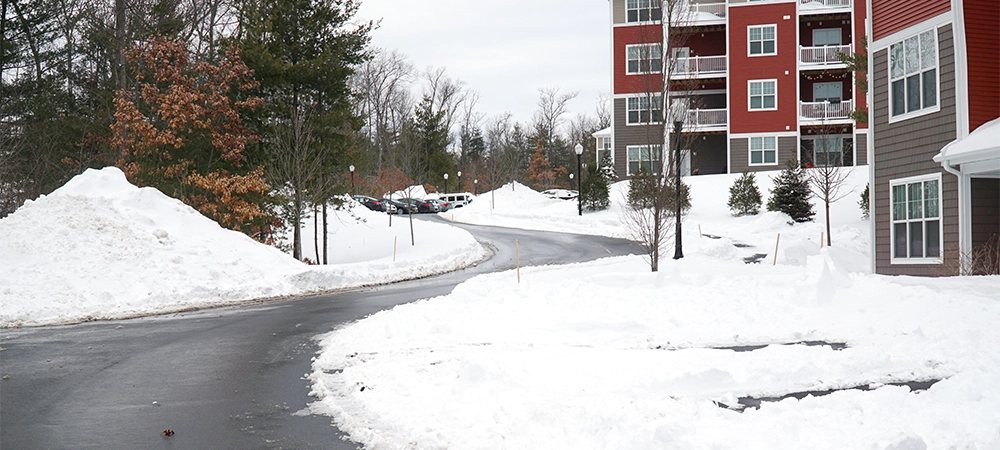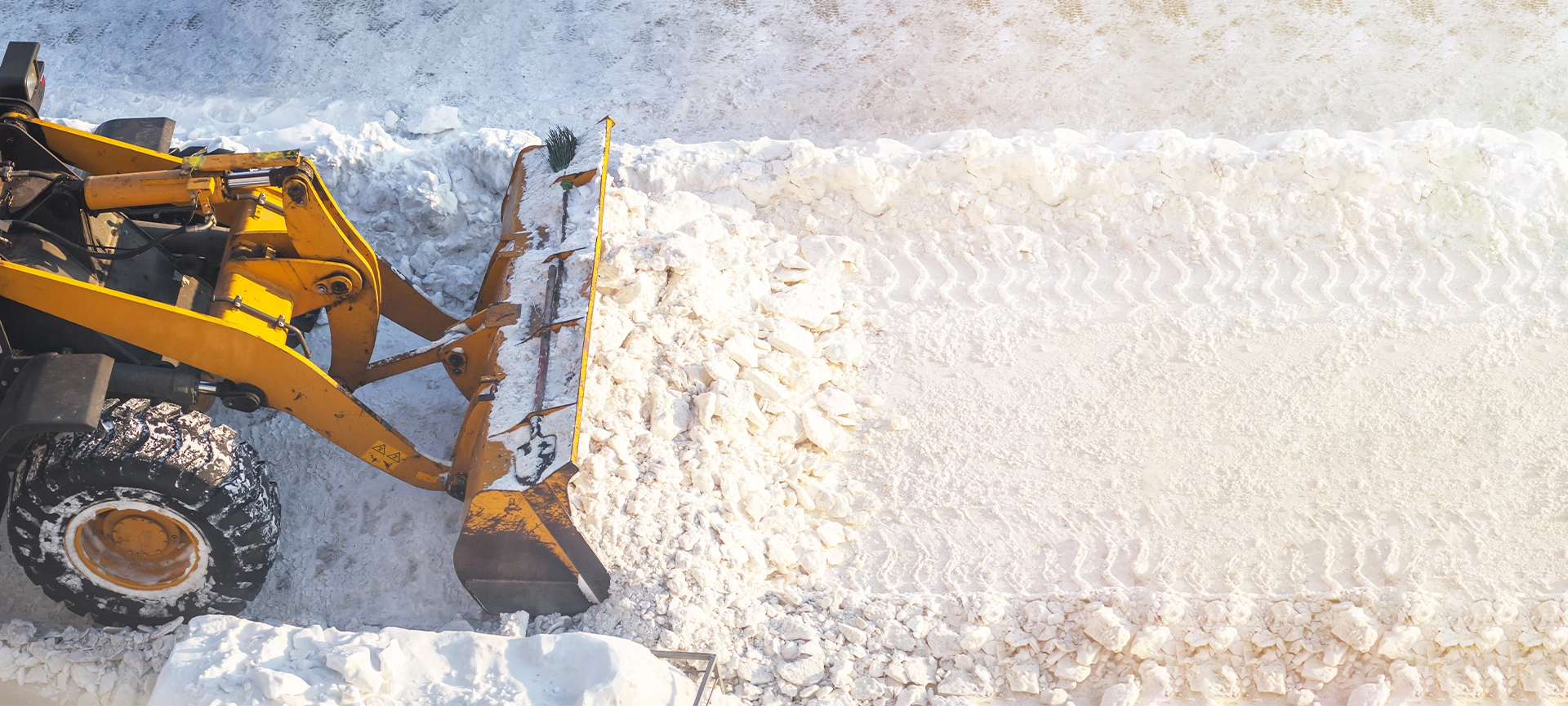
A condo board’s duty of care does not hibernate when the snow piles up. Yet many associations still rely on last-minute salt runs or the superintendent’s shovel. Those tactics expose residents to slips, invite insurance claims, and erode concrete faster than you can say “freeze–thaw cycle.”
A proactive, professional snow removal plan keeps pathways clear, budgets predictable, and board members out of court. The stakes are too high to trust winter safety to chance. Let’s examine why.
Related Article: Is De-Icing Enough? When You Need Full-Service Ice Management
The Real Cost of Snow Mismanagement
Snow looks harmless until you tally the hidden expenses. Emergency call-outs cost 40 to 60 percent more than pre-scheduled service. Staff overtime, calcium chloride, and equipment repairs drive costs further.
Meanwhile, heat loss from blocked vents can inflate the energy bill, and delayed waste collection due to uncleared lanes may trigger municipal fines. Factor in snow-damaged landscaping, and you can burn through a season’s maintenance budget by January. A fixed-price contract locks in rates, trims reactive spending, and frees reserve funds for long-term projects.
Legal and Insurance Risks for Boards
Under Ontario’s Occupiers’ Liability Act, a condo corporation must take “reasonable steps” to keep common areas safe. One icy stairwell can lead to a six-figure lawsuit and a costly premium hike.
Insurers increasingly demand proof of professional logs (time-stamped site visits, de-icing details, and temperature readings) before honouring a claim. A vetted snow contractor supplies digital reports that satisfy both the adjuster and the board’s records. That documentation helps defend against negligence allegations and may even unlock preferred insurance rates.
Related Article: Top 7 Mistakes Businesses Make with Snow and Ice Management
Keeping Residents Safe and Happy
Snow-free entrances mean fewer slip-and-fall incidents and smoother mobility for seniors, children, and people who use wheelchairs. Prompt clearing also reduces resident complaints that monopolize management’s inbox.
Clear visitor parking and loading zones keep deliveries on schedule, a perk for e-commerce savvy occupants. When residents see that the board invests in their safety, satisfaction rises and turnover drops, reinforcing community stability.
Preserving Building Assets and Curb Appeal
Repeated freeze–thaw cycles force melting brine into porous concrete, accelerating spalling and rebar corrosion. Piles left against façades stain brick and leak into underground garages. Professional crews use rubber-bladed ploughs, apply calibrated brine instead of rock salt, and cart excess snow to approved dump sites.
The result: longer pavement life, healthier gardens in spring, and a welcoming façade that supports resale prices.
Municipal Compliance and Environmental Stewardship
Toronto’s Municipal Code requires snow to be cleared within 12 hours of the last flake, while runoff bylaws restrict chloride discharge. Non-compliance invites tickets and negative press.
Reputable firms follow weather services certified by Environment and Climate Change Canada, dispatch before storms hit, and use brine blends that lower salt usage by up to 30 percent. Less salt means lower corrosion, healthier urban trees, and fewer microplastics in Lake Ontario, a win for residents who value sustainable living.

Key Elements of a Professional Snow Removal Plan
A robust plan is more than a plough schedule. A professional commercial snow removal plan should include:
- Site mapping: colour-coded diagrams marking priority zones, hydrants, and catch-basins.
- Service levels: trigger depths, de-icing thresholds, and time-to-clear guarantees.
- Pre-season inspection: joint walkthrough to log surface defects and set benchmarks.
- Meteorological monitoring: 24-hour forecasting with storm alerts to managers.
- Digital reporting: photos, timestamps, and salt quantities for each visit.
- Post-season review: data analysis to refine next winter’s scope.
By codifying expectations, the board can hold vendors accountable and benchmark performance year over year.
Choosing the Right Service Provider
Doing your homework before signing a snow contract protects both residents and the reserve fund. Use this checklist:
- Certificate of Insurance – Secure proof of at least $5 million in commercial general liability coverage.
- WSIB Clearance & Equipment Audit – Verify Workplace Safety and Insurance Board status, confirm equipment age, and ask about spare units to prevent downtime.
- Comparable References – Request three condominium references of similar size, preferably with underground garages.
- Sidewalk-Sized Machinery – Ensure the contractor owns compact units that can clear narrow walkways without damaging pavers.
- TDG-Trained Operators – Confirm staff are certified under the Transportation of Dangerous Goods Regulations for proper salt handling and storage.
- Full Documentation – A firm such as Green Side Up Contracting provides every record up front, streamlining board approval.
Budgeting and Contract Structuring Tips
Fixed-season contracts tame volatile winters, while per-push agreements suit lighter-snow regions. Hybrid models cap total pushes yet add a ceiling to control runaway costs in heavy years.
Allocate contingency funds for ice storms that exceed “average winter” clauses. Insist on performance holdbacks (releasing a final payment only after a spotless spring clean-up) to motivate thorough service until April.
Implementation and Communication Best Practices
Setting clear expectations keeps winter operations smooth and resident relations warm. Follow these steps:
- Distribute the Snow Policy in October – Send it by email, post it in the lobby, and upload it to the property app so every owner sees the rules before the first flake falls.
- Highlight Overnight Parking Bans – Remind residents that cars must be off surface lots during scheduled clearing to avoid towing fees and missed plough passes.
- Encourage Balcony Drain Checks – Ask owners to retract or cover drains so melting snow does not refreeze on façades or sidewalks below.
- Set Up a Winter Hotline – Provide one phone number or app ticket system for icy spots and slip reports; a single channel avoids duplicate work orders and speeds response.
- Run Weekly Log Reviews – Meet with the contractor every week to review service timestamps and salt usage, flagging any missed areas before problems snowball.
Measuring Performance and Continuous Improvement
Key performance indicators such as average response time, salt usage per 100 square metres, and resident complaint counts help boards assess value. Post-storm surveys capture qualitative data, while end-of-season debriefs with the vendor refine trigger depths and equipment deployment. Publishing results in the annual report shows transparency and builds owner trust.

Board-Ready Takeaways
A professional snow removal plan:
- Cuts unexpected expenses and stabilizes budgets.
- Shields the board from liability under the Occupiers’ Liability Act.
- Enhances resident safety and satisfaction.
- Protects concrete, roofing, and landscaping assets.
- Demonstrates environmental responsibility and by-law compliance.
Related Article: The Importance of Regular Snow Removal: Why Timely Service Matters for Your Business
Staying Ahead of the Storm
Winter in the Greater Toronto Area is unpredictable, but your response does not have to be. Investing in a commercial snow removal plan now will spare your condo community legal headaches, costly repairs, and resident frustration when the first nor’easter arrives.
Ready to safeguard your property? Contact Green Side Up Contracting today for a free site audit and tailored snow strategy before the forecast turns white.



